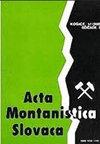Monitoring of the mining waste neutralization facility of LW Bogdanka
IF 1.4
4区 地球科学
Q2 GEOSCIENCES, MULTIDISCIPLINARY
引用次数: 0
Abstract
Investing in renewable energy sources bringing direct profits from unattractive areas is one of the most advantageous ways of wastelands revitalization. In the case of post-mining dumps, it is realized by using photovoltaics and wind turbines. Analyzes showed that the greatest benefits can be acquired from photovoltaic farms, mainly due to the simplicity of their design and principles of operation, as well as the quick return on investment - up to 7 years. The construction of wind turbines is more complicated. Despite the favorable conditions of the mining dumps (elevated areas, which are located mainly away from residential buildings), the construction of the turbine requires more effort in designing and installation work, mainly due to the necessity of building the foundations. Methods for revitalizing mine dumps by installing renewable energy systems have some limitations due to periodicity of operation (time of day, season), weather conditions (wind speed, temperature), expensive energy storage, etc. For this reason, real-time monitoring of climatic conditions is required. The following parameters are monitored: the average available solar energy (important for the assessment of the efficiency of photovoltaic cells), speed and direction of the wind (which affects the efficiency of wind turbines), changes in groundwater level (risk of flooding and periodic soil softening), soil and air temperature (air – affects the choice of the method of revitalization, soil – affects the preservation of soil) and dust concentration, which affects the degree of contamination of the photovoltaic modules and thus the efficiency of the photovoltaic (PV) power plant. The presentation includes interesting data that was obtained during the tests.监测波格丹卡LW采矿废料中和设施
投资于可再生能源,从没有吸引力的地区获得直接利润,是振兴荒地的最有利方式之一。在采矿后倾倒区的情况下,它是通过使用光伏和风力涡轮机来实现的。分析表明,光伏发电场可以获得最大的效益,主要是由于其设计和运行原理简单,以及投资回报快——长达7年。风力涡轮机的建造更为复杂。尽管采矿场(高架区域,主要位于远离住宅楼的地方)条件良好,但涡轮机的建造需要在设计和安装工作中付出更多努力,主要是因为需要建造基础。由于操作周期性(一天中的时间、季节)、天气条件(风速、温度)、昂贵的储能等原因,通过安装可再生能源系统来振兴矿山排土场的方法有一些局限性。因此,需要对气候条件进行实时监测。监测以下参数:平均可用太阳能(对评估光伏电池的效率很重要)、风速和风向(影响风力涡轮机的效率)、地下水位的变化(洪水和周期性土壤软化的风险)、,土壤和空气温度(空气-影响振兴方法的选择,土壤-影响土壤的保存)和灰尘浓度,这会影响光伏组件的污染程度,从而影响光伏发电厂的效率。演示文稿包括在测试过程中获得的有趣数据。
本文章由计算机程序翻译,如有差异,请以英文原文为准。
求助全文
约1分钟内获得全文
求助全文
来源期刊

Acta Montanistica Slovaca
地学-地球科学综合
CiteScore
3.60
自引率
12.50%
发文量
60
审稿时长
30 weeks
期刊介绍:
Acta Montanistica Slovaca publishes high quality articles on basic and applied research in the following fields:
geology and geological survey;
mining;
Earth resources;
underground engineering and geotechnics;
mining mechanization, mining transport, deep hole drilling;
ecotechnology and mineralurgy;
process control, automation and applied informatics in raw materials extraction, utilization and processing;
other similar fields.
Acta Montanistica Slovaca is the only scientific journal of this kind in Central, Eastern and South Eastern Europe.
The submitted manuscripts should contribute significantly to the international literature, even if the focus can be regional. Manuscripts should cite the extant and relevant international literature, should clearly state what the wider contribution is (e.g. a novel discovery, application of a new technique or methodology, application of an existing methodology to a new problem), and should discuss the importance of the work in the international context.
 求助内容:
求助内容: 应助结果提醒方式:
应助结果提醒方式:


